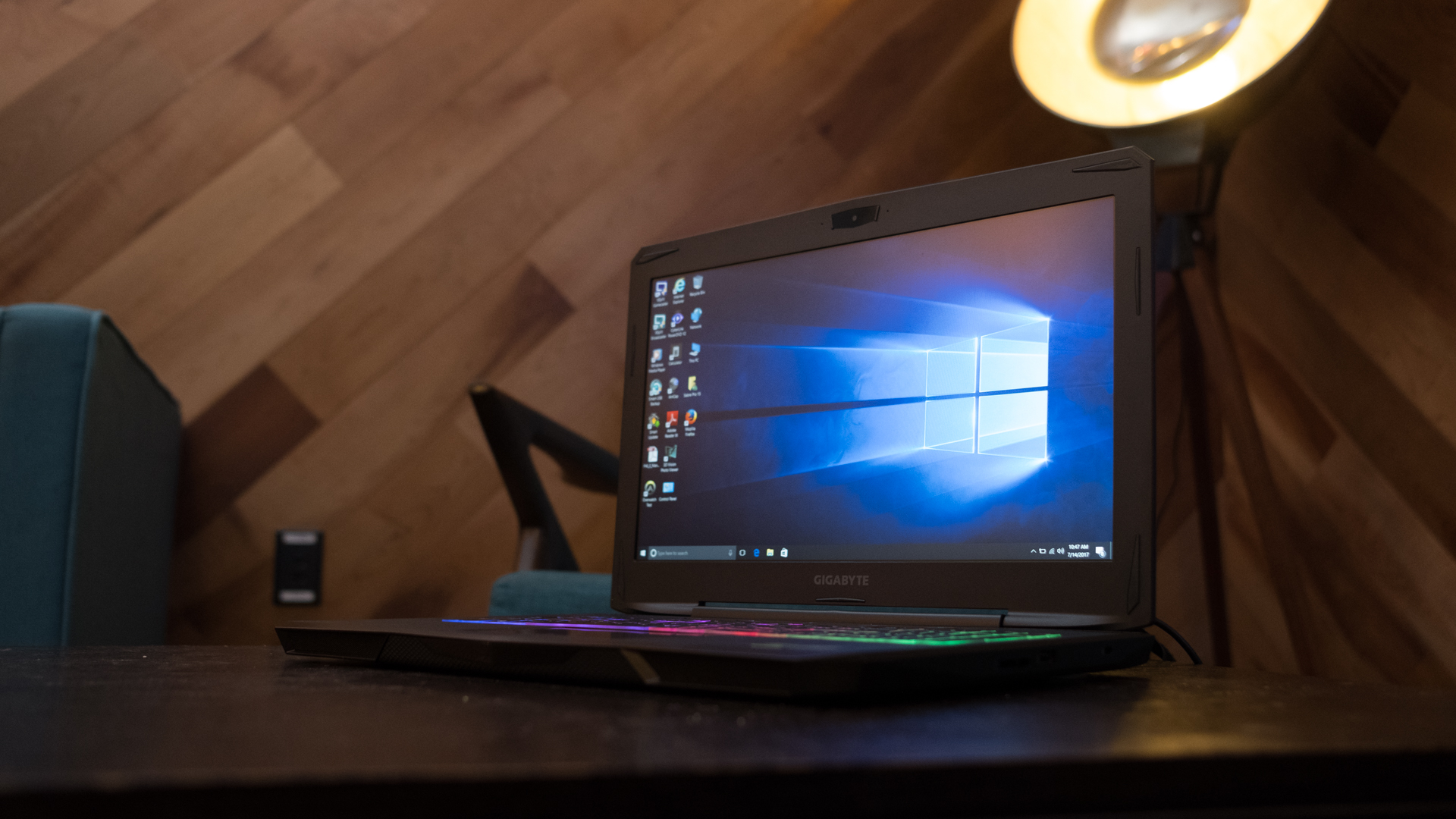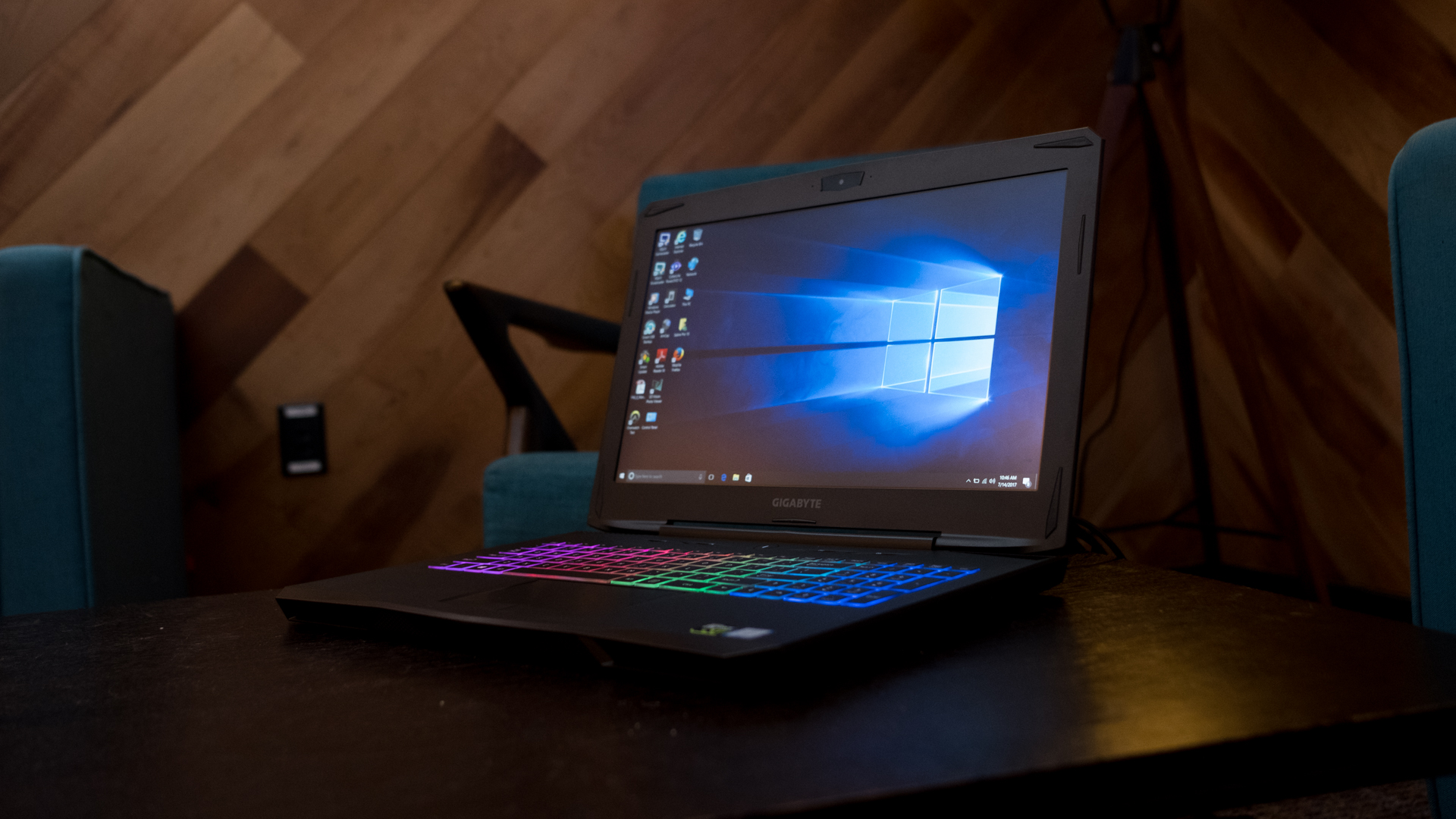TechRadar Verdict
The Gigabyte SabrePro 15 is one of the most decked-out affordable gaming laptops that works well for both tight budgets and those looking for a potent machine.
Pros
- +
Affordable price
- +
Class-leading performance
- +
Excellent keyboard and touchpad
Cons
- -
Below average battery life
- -
Underwhelming speakers and display
- -
Slower SSD storage in retail units
Why you can trust TechRadar
Since Nvidia 10-series Pascal GPUs hit the scene, there haven’t been many truly affordable and powerful gaming laptops. Instead, we’ve had to choose between mid-range Nvidia GTX 1060-powered notebooks normally starting around $1,600 (about £1,400, AU$2,070) or budget friendly Nvidia GTX 1050 Ti laptops that don’t have the chops for 1080p gaming at medium-quality settings.
Gigabyte aims to break that trend with the SabrePro 15, which, as its name might suggest, is a higher-end version of its budget Sabre gaming laptop. The 15-incher comes with a faster processor, better graphics and an RGB keyboard over its affordable cousin – but it stops short of breaking the bank with a starting price of $1,399 (£1,499, AU$2,249).

Here is the Gigabyte SabrePro 15 configuration sent to TechRadar for review:
CPU: 2.8GHz Intel Core i7-7700HQ (quad-core, 6MB cache, up to 3.8GHz)
Graphics: Nvidia GeForce GTX 1060 (6GB GDDR5 VRAM); Intel HD Graphics 630
RAM: 16GB DDR4 (2,400MHz)
Screen: 15.6-inch, Full HD (1920x1080) IPS wide-viewing angle display
Storage: 256GB M.2 NVMe PCIe x4 SSD, 2TB HDD (7,200 rpm)
Ports: 1 x USB 3.1 Type-C, 3 x USB 3.0, 1 x HDMI, 1 x mini DisplayPort, SD card reader, Ethernet, headset jack
Connectivity: 802.11ac Wi-Fi, Bluetooth 4.2
Camera: HD webcam
Weight: 5.5 pounds (2.5kg)
Size: 15.4 x 10.5 x 0.9 inches (39 x 26.8 x 2.5cm; W x D x H)
Price and availability
For what you’re getting inside, the Gigabyte SabrePro 15 is a steal at $1,399 (£1,499, AU$2,249).
Unfortunately, there are two catches with this price tag. The first being that this laptop only comes in one configuration. Secondly, our review unit has a few components you won’t find in the retail version, including an NVMe PCIe x4 SSD that’s faster than the offered M.2 SATA 3 speed flash storage, as well as a hard drive with twice the capacity compared to what’s found in consumer units.
Even with those more realistic specs in mind, the Gigabyte SabrePro 15 is far more affordable than other equally powerful gaming laptops, like the $1,899 (£1,799, AU$2,799) Razer Blade or the $2,073 (about £1,630, AU$2,730) Origin EVO15-S – the latter of which is only available in the US.
The only gaming laptops to come close to offering the same value is the $1,399 (about £1,100, AU$1,840) Acer Predator Helios 300.

Design
Design-wise, the SabrePro is a departure from Gigabyte’s toned-down looks. Rather, this 15-inch feels and looks like the quintessential gaming laptop that also took a page out of Michael Bay’s take on Transformers.
Sign up for breaking news, reviews, opinion, top tech deals, and more.
The SabrePro’s design is part stealth bomber and hyper car that includes bevels, nipped corners, points and curves on every end. Save for the sides of the laptop, there aren’t any flat edges on this machine. There are so many facets to this laptop that a few end up clashing with the rest of the laptop, such as its curved backend, whereas the rest of its shape is fairly geometric.
Altogether, it’s a very busy design that seems like it’s trying too hard to keep things interesting. Whether you’ll like this look also will depend on your personal preference, though.

Styling aside, the SabrePro is functionally well designed. Thanks to the slightly forward position of the screen hinge, you’ll find desk-friendly ports on the back of the machine including one for Ethernet, plus video out and power connectors.
Meanwhile, the gaming notebook’s extended front end also allows for front-facing speakers that offer suitable stereo separation – even if they’re a touch too quiet.

Of course, there’s a downside with the bigger chassis in that the SabrePro is both bigger and heavier than its competitors.
While this Gigabyte 15-inch measures 15.4 x 10.5 x 0.9 inches (39 x 26.8 x 2.5cm; W x D x H), the Razer Blade and Origin EON15-S are smaller at 13.6 x 9.3 x 0.70 inches (34.5 x 23.5 x 1.79mm) and 15 x 9.8 x 0.69 inches (38.1 x 24.8 x 1.75cm), respectively.
The Sabre Pro is also a full pound and a half heavier than the MSI GS63VR Stealth Pro, which is the same underlying chassis as Origin’s thin-and-light 15-inch gaming laptop.

Decked out
Another highlight of the Gigabyte SabrePro 15 is the keyboard, which offers the most satisfying amount of 2mm of key travel we’ve had on a traditional gaming laptop. That’s even compared to other machines with mechanical-type keys, like the Razer Blade Pro and MSI GT75VR Titan, though, there isn’t a sharp click when you bottom out the keys.
We’re also not crazy about having the number pad jammed into the arrow keys, which often leads us to scrolling up and down the page when we meant to enter digits or vice-versa. Gigabyte could easily fix this problem by moving the arrow keys a step below the rest of the keyboard.

Unlike most gaming laptop’s, Gigabyte opted to move the macro keys above the keyboard rather than leaving them off to the side. Not only does this give more space for a roomier keyboard, we feel they’re a bit more accessible. Outside of gaming, you can also program these macro keys to cycle power modes, ramp up the fans to the max and assign other quick-access settings.
Surprisingly, the SabrePro also integrates a Microsoft Precision Touchpad and thus the nearly perfect 1:1 tracking with solid multi-touch gesture recognition you should expect.

Kevin Lee was a former computing reporter at TechRadar. Kevin is now the SEO Updates Editor at IGN based in New York. He handles all of the best of tech buying guides while also dipping his hand in the entertainment and games evergreen content. Kevin has over eight years of experience in the tech and games publications with previous bylines at Polygon, PC World, and more. Outside of work, Kevin is major movie buff of cult and bad films. He also regularly plays flight & space sim and racing games. IRL he's a fan of archery, axe throwing, and board games.
